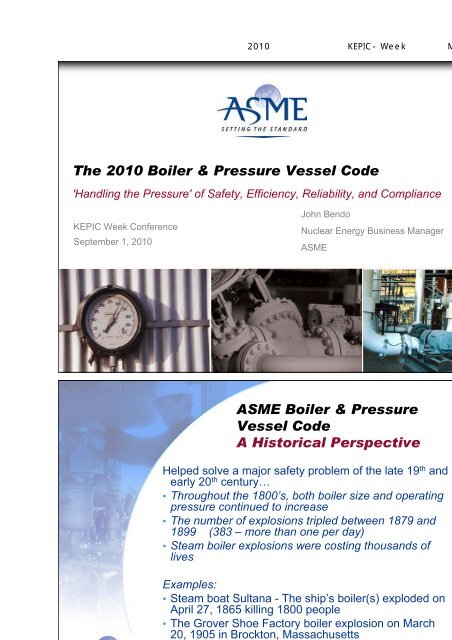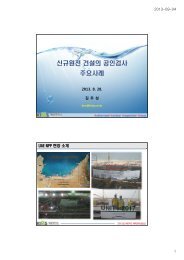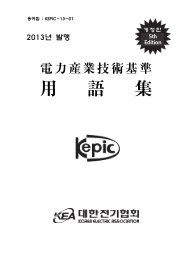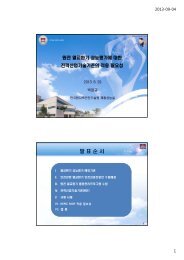The 2010 Boiler & Pressure Vessel Code ASME Boiler & Pressure ...
The 2010 Boiler & Pressure Vessel Code ASME Boiler & Pressure ...
The 2010 Boiler & Pressure Vessel Code ASME Boiler & Pressure ...
Create successful ePaper yourself
Turn your PDF publications into a flip-book with our unique Google optimized e-Paper software.
<strong>2010</strong>년도 대한전기협회 KEPIC-Week 발표자료 MN1-5<br />
<strong>The</strong> <strong>2010</strong> <strong>Boiler</strong> & <strong>Pressure</strong> <strong>Vessel</strong> <strong>Code</strong><br />
'Handling the <strong>Pressure</strong>' of Safety, Efficiency, Reliability, and Compliance<br />
KEPIC Week Conference<br />
September 1, <strong>2010</strong><br />
John Bendo<br />
Nuclear Energy Business Manager<br />
<strong>ASME</strong><br />
<strong>ASME</strong> <strong>Boiler</strong> & <strong>Pressure</strong><br />
<strong>Vessel</strong> <strong>Code</strong><br />
A Historical Perspective<br />
Helped solve a major safety problem of the late 19 th and<br />
early 20 th century…<br />
• Throughout the 1800’s, both boiler size and operating<br />
pressure continued to increase<br />
• <strong>The</strong> number of explosions tripled between 1879 and<br />
1899 (383 – more than one per day)<br />
• Steam boiler explosions were costing thousands of<br />
lives<br />
Examples:<br />
• Steam boat Sultana - <strong>The</strong> ship’s boiler(s) exploded on<br />
April 27, 1865 killing 1800 people<br />
• <strong>The</strong> Grover Shoe Factory boiler explosion on March<br />
20, 1905 in Brockton, Massachusetts<br />
- 43 -
R. B. Grover & Company Shoe Factory<br />
Before <strong>Boiler</strong> Explosion<br />
R. B. Grover & Company Shoe Factory<br />
After <strong>Boiler</strong> Explosion<br />
… 58 people were killed and 150 were injured.<br />
- 45 -
<strong>ASME</strong> <strong>Boiler</strong> & <strong>Pressure</strong> <strong>Vessel</strong> <strong>Code</strong><br />
A Historical Perspective<br />
• Following a number of explosions of this type states<br />
began to develop their own boiler laws.<br />
• This led to the development of different laws among the<br />
states.<br />
• An <strong>ASME</strong> Committee developed the <strong>Boiler</strong> <strong>Code</strong><br />
between 1911 and 1914.<br />
• Provided for safe construction and promoted commerce<br />
through consistency of requirements.<br />
<strong>The</strong> methodology used in creating the<br />
<strong>Boiler</strong> <strong>Code</strong> “set the standard” for<br />
modern code-development.<br />
Trend for <strong>Boiler</strong> Explosions in the U.S.<br />
5000 psi<br />
1600 psi<br />
400 psi<br />
650 psi<br />
500 psi<br />
PRESSURE LEVEL<br />
- 46 -
<strong>ASME</strong> <strong>Boiler</strong> & <strong>Pressure</strong> <strong>Vessel</strong> <strong>Code</strong><br />
• Comprehensive and practical:<br />
• Evolved from 114 pages to today’s 14,000+ pages<br />
• Covers industrial and residential boilers, pressure<br />
vessels, nuclear facility components, and transport<br />
tanks<br />
• Reflects industry best-practices, offering real-world<br />
solutions developed by experts in the field<br />
• Worldwide influence:<br />
• Adopted in whole or in part by all U.S. states and<br />
Canadian provinces<br />
• Accepted as a possible means to meet local<br />
pressure equipment regulations by more than 100<br />
nations<br />
Global Growth<br />
Certified <strong>Boiler</strong> & <strong>Pressure</strong> <strong>Vessel</strong> Manufacturers (Non-Nuclear)<br />
5,000<br />
Certified Manufacturers<br />
4,000<br />
3,000<br />
2,000<br />
1,000<br />
0<br />
74 76 78 80 82 84 86 88 90 92 94 96 98 00 02 04 06 08<br />
U.S. & Canada International Total<br />
Data as of 2009-06-30<br />
- 47 -
<strong>ASME</strong> Section III Nuclear Certificates by Company<br />
600<br />
500<br />
Number of Companies Holding Certificates<br />
400<br />
300<br />
200<br />
Total<br />
North America<br />
International<br />
100<br />
0<br />
1980 1985 1990 1995 2000 2005 <strong>2010</strong><br />
Year [Data through July 31, <strong>2010</strong>]<br />
Total Number of <strong>ASME</strong> Nuclear Certificates<br />
400<br />
350<br />
US Nuclear<br />
Component<br />
Certificates<br />
International Nuclear<br />
Component Certificates<br />
Total US<br />
Certificates<br />
Total International<br />
Certificates<br />
300<br />
Number of Certificates<br />
250<br />
200<br />
150<br />
100<br />
50<br />
US Nuclear Materials<br />
Certificates<br />
International Nuclear<br />
Materials Certificates<br />
0<br />
Data through July 31, <strong>2010</strong><br />
- 48 -
<strong>ASME</strong> Develops <strong>Code</strong>s and Standards for Many Industries<br />
Authorized Inspections<br />
Automotive<br />
Bioprocess<br />
Blanks<br />
<strong>Boiler</strong><br />
Certification & Accreditation (C&S)<br />
Chains<br />
Chemical/Process<br />
Compressors<br />
Computational/Analysis<br />
Computing/Information Science in Engineering<br />
Controls<br />
Conveyors<br />
Cranes and Hoists<br />
Design<br />
Elevators and Escalators<br />
Energy Efficiency<br />
Engineering Drawing & Related Practices<br />
Environmental<br />
Fasteners<br />
Fitness-For-Service<br />
Fittings, Flanges & Gaskets<br />
Fossil<br />
Gauges/Gaging<br />
Geometric Dimensioning & Tolerancing (GD&T)<br />
Heating, Ventilating and Air-Conditioning<br />
High <strong>Pressure</strong> <strong>Vessel</strong>s/Systems<br />
Industrial Gas<br />
Internal Combustion Engine<br />
Keys & Keyseats<br />
Limits & Fits<br />
Materials<br />
Measurement<br />
Medical/Health<br />
Metal Products Sizes<br />
Metric System<br />
Noise Control and Acoustics<br />
Non-Personnel & Personnel Lifting Devices<br />
Nondestructive Evaluation/Examination<br />
Nuclear<br />
Operator Qualification and Certification<br />
Performance Test <strong>Code</strong>s<br />
Piping & Pipelines<br />
Plant Operations<br />
Plumbing<br />
Post Construction<br />
<strong>Pressure</strong> <strong>Vessel</strong>s<br />
Pumps<br />
Rail Transportation<br />
Reinforced <strong>The</strong>rmo, Plastic Corrosion<br />
Resistance<br />
Renewable/Alternative Energy<br />
Risk Analysis<br />
Screw Threads<br />
Steam Table<br />
Steel Stacks<br />
Surface Quality<br />
Testing<br />
Textile Engineering<br />
Tools<br />
Turbines<br />
Valves<br />
Waste<br />
Water Management<br />
Welding & Brazing<br />
<strong>ASME</strong> <strong>Code</strong> Products<br />
<strong>Boiler</strong> and <strong>Pressure</strong> <strong>Vessel</strong> <strong>Code</strong><br />
• Section I - Power <strong>Boiler</strong>s<br />
• Section II - Materials<br />
• Section III - Rules for Construction of<br />
Nuclear Facility Components<br />
• Section IV - Heating <strong>Boiler</strong>s<br />
• Section V - Nondestructive Examination<br />
• Section VI - Recommended Rules for the<br />
Care and Operation of Heating <strong>Boiler</strong>s<br />
- 49 -
<strong>ASME</strong> <strong>Code</strong> Products<br />
<strong>Boiler</strong> and <strong>Pressure</strong> <strong>Vessel</strong> <strong>Code</strong><br />
• Section VII - Recommended Guidelines for<br />
the Care of Power <strong>Boiler</strong>s<br />
• Section VIII - <strong>Pressure</strong> <strong>Vessel</strong>s<br />
• Section IX - Welding and Brazing<br />
Qualifications<br />
• Section X - Fiber-Reinforced Plastic<br />
<strong>Pressure</strong> <strong>Vessel</strong>s<br />
• Section XI - Rules for Inservice Inspection<br />
of Nuclear Power Plant Components<br />
• Section XII - Rules for the Construction and<br />
Continued Service of Transport Tanks<br />
Complementary<br />
<strong>ASME</strong> <strong>Code</strong> Products<br />
B31 Piping and Pipeline <strong>Code</strong>s<br />
• B31.1 Power Piping<br />
• B31.3 Process Piping<br />
• B31.4 Pipeline Transportation Systems for Liquid<br />
Hydrocarbons and Other Liquids<br />
• B31.8 Gas Transmission & Distribution Piping<br />
Systems<br />
• B31.8S Managing System Integrity of Gas<br />
Pipelines<br />
• B31Q Pipeline Personnel Qualification<br />
• B31.12 Hydrogen Piping & Pipelines (In<br />
Development)<br />
- 50 -
Complementary<br />
<strong>ASME</strong> <strong>Code</strong> Products<br />
• 33 B16 Standards covering valves, flanges,<br />
gaskets and fittings<br />
• Post Construction:<br />
• PCC-1 Guidelines for <strong>Pressure</strong> Boundary<br />
Bolted Flange Joint Assembly<br />
• PCC-2 Repair of <strong>Pressure</strong> Equipment and<br />
Piping<br />
• PCC-3 Risk-Based Inspection<br />
• Reinforced <strong>The</strong>rmoset Plastic Corrosion<br />
Resistant Equipment (RTP-1)<br />
• Fitness for Service (API-579/<strong>ASME</strong> FFS-1)<br />
Complementary<br />
<strong>ASME</strong> Nuclear <strong>Code</strong>s & Standards<br />
•AG-1 - <strong>Code</strong> on Nuclear Air and Gas Treatment<br />
•N509 - Nuclear Power Plant Air-Cleaning Units and<br />
Components<br />
•N510 - Testing of Nuclear Air-Treatment Systems<br />
•N511 - In-Service Testing of Nuclear Air Treatment,<br />
Heating, Ventilating, and Air-Conditioning Systems<br />
•NQA-1 - Quality Assurance Requirements for Nuclear<br />
Facility Applications (QA)<br />
•RA-S - Probabilistic Risk Assessment for Nuclear<br />
Power Plant Applications (PRA)<br />
- 51 -
Complementary<br />
<strong>ASME</strong> Nuclear <strong>Code</strong>s & Standards<br />
•NOG-1 - Rules for Construction of Overhead and<br />
Gantry Cranes (Top Running Bridge, Multiple Girder)<br />
•NUM-1 - Rules for Construction of Cranes, Monorails,<br />
and Hoists (with Bridge or Trolley or Hoist of the<br />
Underhung Type)<br />
•OM - <strong>Code</strong> for Operation and Maintenance of Nuclear<br />
Power Plants<br />
•PTC 32.1 - Nuclear Steam Supply Systems<br />
•QME-1 - Qualification of Active Mechanical<br />
Equipment used in Nuclear Power Plants<br />
<strong>ASME</strong> <strong>Boiler</strong> & <strong>Pressure</strong> <strong>Vessel</strong> <strong>Code</strong><br />
<strong>2010</strong> Edition – Highlights & Changes<br />
- 52 -
<strong>ASME</strong> <strong>Boiler</strong> & <strong>Pressure</strong> <strong>Vessel</strong> <strong>Code</strong><br />
<strong>2010</strong> Edition – Highlights & Changes<br />
Section I – Power <strong>Boiler</strong>s<br />
• Added heat recovery steam generators to<br />
the list of equipment covered<br />
• Revised to enable the use of alternative<br />
design methods when details of design are<br />
not given in the <strong>Code</strong><br />
• Revisions to permit inclusion of clad<br />
thickness in the calculated strength of<br />
boiler tubes<br />
• Impose Weld Joint Strength Reduction<br />
Factors on certain welds<br />
<strong>ASME</strong> <strong>Boiler</strong> & <strong>Pressure</strong> <strong>Vessel</strong> <strong>Code</strong><br />
<strong>2010</strong> Edition – Highlights & Changes<br />
Section II - Materials<br />
• Part A: Ferrous Material Specifications - Updated<br />
more than 90 ferrous specifications<br />
• Part B: Nonferrous Material Specifications -<br />
Updated more than 50 nonferrous specifications<br />
• Part C: Specifications for Welding Rods,<br />
Electrodes and Filler Metals - Updated 7 welding<br />
material specifications<br />
• Part D: Properties (Customary) - More than 15<br />
stress lines added; more than 25 stress lines<br />
revised; new Table covering Poisson’s ratio and<br />
density<br />
- 53 -
<strong>ASME</strong> <strong>Boiler</strong> & <strong>Pressure</strong> <strong>Vessel</strong> <strong>Code</strong><br />
<strong>2010</strong> Edition – Highlights & Changes<br />
Section III – Rules for Construction of Nuclear Facility Components<br />
• Division 1<br />
• Subsection NCA General Requirements (Divisions 1 & 2)<br />
• Subsection NB-Class 1 Components (Division 1)<br />
• Subsection NC-Class 2 Components (Division 1)<br />
• Subsection ND-Class 3 Components (Division 1)<br />
• Subsection NE-Class MC Components (Division 1)<br />
• Subsection NF-Supports (Division 1)<br />
• Subsection NG-Core Support Structures (Division 1)<br />
• Subsection NB-Class 1 Components in Elevated Temperature<br />
Service (Division 1)<br />
• Appendices (Division 1)<br />
• Division 2 – <strong>Code</strong> for Concrete Reactor <strong>Vessel</strong>s and Containments<br />
• Division 3 – Containments for Transportation & Storage of Spent<br />
Nuclear Fuel & High Level Radioactive Material and Waste<br />
<strong>ASME</strong> <strong>Boiler</strong> & <strong>Pressure</strong> <strong>Vessel</strong> <strong>Code</strong><br />
<strong>2010</strong> Edition – Highlights & Changes<br />
Section III – Rules for Construction of Nuclear<br />
Facility Components<br />
• Clarified requirements for standard impact test<br />
specimen material for Charpy V-Notch test<br />
machine calibration<br />
• Updated and consolidated reference standards<br />
into Article NCA-7000<br />
• Appendix F revised to provide requirements for<br />
support fillet welds.<br />
• Consolidated common requirements in NB-4622<br />
and provided specific requirements for base metal<br />
repairs, cladding repairs and repairs to dissimilar<br />
joints<br />
- 54 -
<strong>ASME</strong> <strong>Boiler</strong> & <strong>Pressure</strong> <strong>Vessel</strong> <strong>Code</strong><br />
<strong>2010</strong> Edition – Highlights & Changes<br />
Section III – Rules for Construction of Nuclear<br />
Facility Components<br />
• Revised NF-1132 to clarify jurisdiction boundary<br />
for bolts to building structure<br />
• Revised NCA to update references to NQA-1 2008<br />
and/or NQA-1a 2009 addenda<br />
• Revised NCA to address PE (polyethylene) source<br />
material and piping material and provide rules for<br />
qualification of Polyethylene Material Suppliers<br />
• Revised NCA-5125 (b) to require ANI Supervisor<br />
Audit to include N and NV Certificate Holders<br />
<strong>ASME</strong> <strong>Boiler</strong> & <strong>Pressure</strong> <strong>Vessel</strong> <strong>Code</strong><br />
<strong>2010</strong> Edition – Highlights & Changes<br />
Section IV – Heating <strong>Boiler</strong>s<br />
• Added requirements to allow the stamping of cast<br />
aluminum boilers<br />
• Added new Aluminum materials to the Table of<br />
allowed materials.<br />
• Nonmandatory Appendix I was updated<br />
- 55 -
<strong>ASME</strong> <strong>Boiler</strong> & <strong>Pressure</strong> <strong>Vessel</strong> <strong>Code</strong><br />
<strong>2010</strong> Edition – Highlights & Changes<br />
Section V – Nondestructive Examination<br />
• Clarified requirements for radiography<br />
using phosphor imaging plates<br />
• Updated or revised over 15 ASTM<br />
specifications related to NDE<br />
• Added or revised various definitions to<br />
clarify the use of NDE terms<br />
• Clarified the requirements for ultrasonic<br />
performance demonstration criteria.<br />
<strong>ASME</strong> <strong>Boiler</strong> & <strong>Pressure</strong> <strong>Vessel</strong> <strong>Code</strong><br />
<strong>2010</strong> Edition – Highlights & Changes<br />
Section VIII – <strong>Pressure</strong> <strong>Vessel</strong>s<br />
Division 1<br />
• Added requirements for pressure vessels<br />
constructed of impregnated graphite<br />
• Revised UG-90(c)(2) and added Mandatory<br />
Appendix 35 addressing Rules for Mass<br />
Production of <strong>Pressure</strong> <strong>Vessel</strong>s<br />
• Added Rules for Bolting Pads, Qualification of<br />
Nondestructive Examination Personnel and<br />
Requirements for Split Reinforcing Pads for<br />
Nozzles.<br />
• Revised Appendix 26 to limit the design<br />
temperature to 800 F and permit use of the<br />
operating temperature properties for the fatigue<br />
analysis.<br />
- 56 -
<strong>ASME</strong> <strong>Boiler</strong> & <strong>Pressure</strong> <strong>Vessel</strong> <strong>Code</strong><br />
<strong>2010</strong> Edition – Highlights & Changes<br />
Section VIII – <strong>Pressure</strong> <strong>Vessel</strong>s<br />
Division 2 – Alternative Rules<br />
• Added guidance to accommodate loadings<br />
produced by deflagration<br />
• Made tubesheet requirements consistent with<br />
Part UHX of Section VIII, Division 1<br />
• Added requirements for Qualification of<br />
Nondestructive Examination Personnel<br />
• Added PWHT requirements for some materials<br />
<strong>ASME</strong> <strong>Boiler</strong> & <strong>Pressure</strong> <strong>Vessel</strong> <strong>Code</strong><br />
<strong>2010</strong> Edition – Highlights & Changes<br />
Section VIII – <strong>Pressure</strong> <strong>Vessel</strong>s<br />
Division 3 - Alternative Rules for the<br />
Construction of High <strong>Pressure</strong> <strong>Vessel</strong>s<br />
• Incorporated the structural stress method for<br />
fatigue analysis of welded joints from Division 2<br />
• Added requirements for Qualification of<br />
Nondestructive Examination Personnel<br />
• Added wording for performance of UT in lieu of<br />
RT<br />
• Incorporated structural stress method for fatigue<br />
analysis of welded joints from Division 2<br />
• Incorporated Elastic-Plastic Analysis from<br />
Division 2<br />
- 57 -
<strong>ASME</strong> <strong>Boiler</strong> & <strong>Pressure</strong> <strong>Vessel</strong> <strong>Code</strong><br />
<strong>2010</strong> Edition – Highlights & Changes<br />
Section IX – Welding and Brazing<br />
Qualifications<br />
• Reassigned S-Numbers as P-Numbers for<br />
welding and brazing procedure qualification<br />
purposes (including updating tables)<br />
• Revised welding forms to reflect current welding<br />
variables and terminology<br />
• Revised QW/QB-422 to indicate the assigned<br />
ISO/TR 15608 Material Grouping Number<br />
<strong>ASME</strong> <strong>Boiler</strong> & <strong>Pressure</strong> <strong>Vessel</strong> <strong>Code</strong><br />
<strong>2010</strong> Edition – Highlights & Changes<br />
Section X – Fiber-Reinforced Plastic<br />
<strong>Pressure</strong> <strong>Vessel</strong>s<br />
• Revised to allow acceptance test of vessels<br />
designed to operate at elevated temperature to be<br />
conducted at ambient temperature<br />
• Revised requirement for frequency of volumetric<br />
expansion tests.<br />
• Removed requirements for the assembly of the<br />
UV stamp, which are outside the scope of Section<br />
X.<br />
• Revised some thickness formulas to simplify and<br />
make them similar to <strong>ASME</strong> RTP-1<br />
• Deleted word "vacuum" throughout the code.<br />
• Revised to require attaching the partial data<br />
reports to the primary data report to provide<br />
traceability<br />
- 58 -
<strong>ASME</strong> <strong>Boiler</strong> & <strong>Pressure</strong> <strong>Vessel</strong> <strong>Code</strong><br />
<strong>2010</strong> Edition – Highlights & Changes<br />
Section XI – Rules for Inservice Inspection of<br />
Nuclear Power Plant Components<br />
• Revised to require additional examinations when<br />
new flaws or significant changes in flaw<br />
characteristics resulted in necessary corrective<br />
actions<br />
• Incorporated guidance for pressure testing of<br />
open-ended discharge piping<br />
• Made revisions to permit the Owner to use the<br />
personnel qualifications, methods, and acceptance<br />
criteria for repair/replacement activities<br />
• Provided guidelines for evaluating non-destructive<br />
examination coverage percentages<br />
• Added new paragraphs and a form addressing the<br />
Owner's and Repair/Replacement Organizations<br />
responsibility in preparation of reports<br />
documenting repair/replacement activities<br />
<strong>ASME</strong> <strong>Boiler</strong> & <strong>Pressure</strong> <strong>Vessel</strong> <strong>Code</strong><br />
<strong>2010</strong> Edition – Highlights & Changes<br />
Section XI – Rules for Inservice Inspection of<br />
Nuclear Power Plant Components<br />
• Revised the flaw Acceptance Standards for Class 1<br />
ferritic and austenitic piping<br />
• Revised to clarify that the examination<br />
requirements do not apply to atmospheric or 0 to<br />
15 psig (0 kPa to 100 kPa) storage tanks<br />
• Incorporated analytical procedures and material<br />
properties for evaluation of flaws in piping and<br />
welds fabricated of Alloy 600/82/182/132 in both<br />
PWR and BWR environments<br />
• Added a new article to include IGSCC growth rate<br />
equations for unirradiated, austenitic stainless<br />
steels exposed to BWR reactor water<br />
environments<br />
• Revised the examination requirements for cladding<br />
to be consistent with Section III<br />
- 59 -
<strong>ASME</strong> <strong>Boiler</strong> & <strong>Pressure</strong> <strong>Vessel</strong> <strong>Code</strong><br />
<strong>2010</strong> Edition – Highlights & Changes<br />
Section XII – Rules for Construction and<br />
Continued Service of Transport Tanks<br />
• Added rules covering local thin areas in transport<br />
tanks<br />
• Added an appendix covering ton containers<br />
• Added guidelines for the design of supports and<br />
safety devices for cargo tanks<br />
Developments in Nuclear <strong>Code</strong>s and Standards<br />
Section III – Rules for Construction of Nuclear<br />
Facility Components<br />
• Division 4 – Magnetic Confinement Fusion Energy<br />
Devices<br />
• Division 5 – High Temperature Reactors<br />
_______________________________________________<br />
Section XI – Rules for Inservice Inspection of<br />
Nuclear Power Plant Components<br />
• Division 2 - Gas-cooled Nuclear Power Plants<br />
• Division 3 - Liquid-metal-cooled Nuclear Power Plants<br />
- 60 -
















